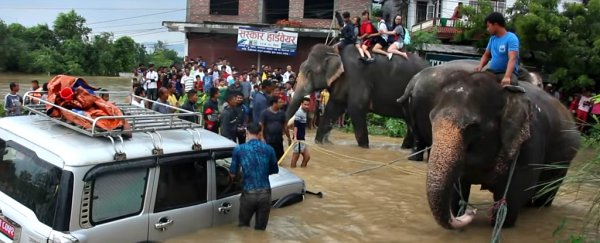Devastating floods and landslides have hit India, Nepal, and Bangladesh over the past week, as the monsoon season has brought extremely heavy rains.
Amidst reports of rising death tolls in the region, there's one flicker of positivity - footage has emerged of trained elephants helping with the rescue efforts, as they carry people to safety from areas where they've been trapped by raging floodwater.
On Monday, some 600 tourists got stranded in Sauraha, a popular destination 152 km (95 miles) south-west of Nepal's capital Kathmandu.
Local business owners deployed elephants and tractor trailers to carry the guests to safety, reaching the nearest open road and the local airport.
"We are mobilising all the resources we have to ensure that everyone is safe," local district chief Narayan Prasad Bhatta told BBC News. You can see elephants helping with the rescue mission in the AFP video below:
The Asian elephants mobilised for these rescues are captive animals that are used for transportation in the region fairly often. Intelligent and empathetic, they are able to sense the direness of a natural disaster.
"They would understand that a person is in trouble and that it's a dangerous situation," elephant expert Joyce Poole told Sarah Gibbens at National Geographic.
But unfortunately there's a dark side to this story, too.
Even though elephants carry a deep cultural significance in Asia where people have been taming them for thousands of years, human relationship with the now-endangered species is highly problematic.
This is especially true of captive elephants used for tourism purposes - to offer people rides and photo opportunities. As elephants don't breed well in captivity, calves are captured from the wild and "broken in", often with harsh training methods.
Earlier this year a report from World Animal Protection (WAP) charity showed that three-quarters of the nearly 3,000 captive elephants assessed were found to live in severely cruel conditions.
Already last year the mammoth tourism website TripAdvisor announced the end of ticket sales to wildlife attractions that exploit animals, including elephant rides and dolphin swims.
According to WAP, captive elephants have the best lives when they don't directly have to interact with people, but tourists can still watch them from afar.
"There is an urgent need for tourist education and regulation of wildlife tourist attractions worldwide," Jan Schmidt-Burbach from WAP told BBC News in June.
"Venues that offer tourists a chance to watch elephants in genuine sanctuaries are beacons of hope that can encourage the urgently-needed shift in the captive elephant tourism industry."
So, despite the fact these heroic elephants in Nepal just saved many lives, it's important to keep in mind wider problems associated with the taming of these majestic animals.
